Bennemann K.H., Ketterson J.B. Superconductivity: Volume 1: Conventional and Unconventional Superconductors; Volume 2: Novel Superconductors
Подождите немного. Документ загружается.

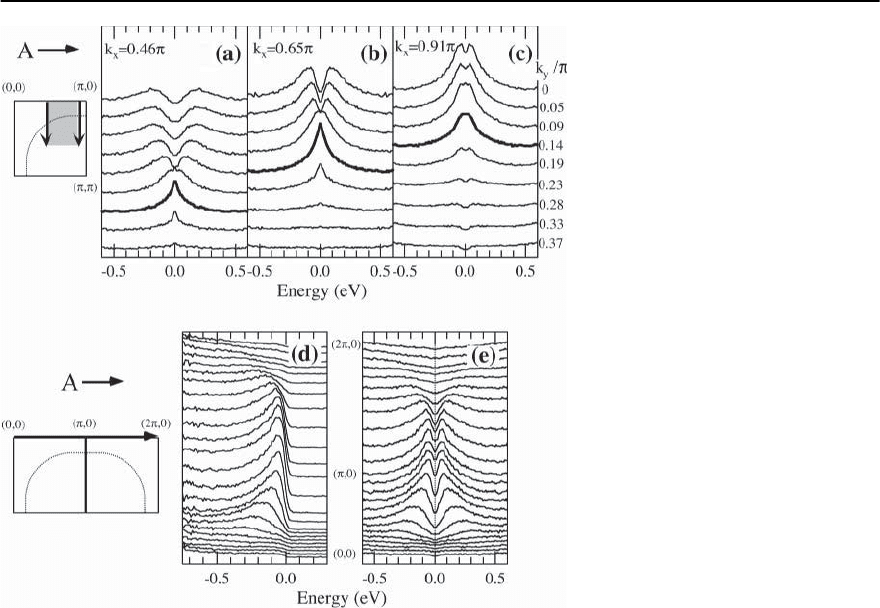
17 Photoemission in the High-T
c
Superconductors 939
Fig. 17.10. (a), (b), c) Symmetrized
EDCs along cuts parallel to (, 0) to
(, ) for OD 23K Bi2201 at T =25K
using h =22eV photons. The curve
corresponding to k
F
along each cut is
determined as explained in the text and
is shown by a thick line.(d)EDCsalong
the (0, 0) → (2 , 0) direction.(e)Sym-
metrized curves corresponding to the
data in (d), showing the absence of a
Fermi surface crossing along (0, 0) to
(, 0)
The“divided”data permits one to clearly observe the
dispersion well above E
f
particularly at high temper-
atures, and thereby identify the Fermi crossings with
a great degree of confidence.
An alternative approach [8] to eliminating the
Fermi function is to symmetrize the data. For each
k define the symmetrized intensity by I
sym
(k
F
, !)=
I(k
F
, !)+I(k
F
, −!)=I
0
A
sym
(k
F
, !). It is easy to
show that I
sym
(!) will exhibit a local minimum, or
dip,at ! = 0 for anoccupiedk state,whileitwillshow
alocalmaximumat! = 0 for an unoccupiedk state.
In practice,then,the Fermi crossing k
F
is determined
as follows:All EDCs along a cut are symmetrized and
k
F
is identified as the boundary in k-space between
points where I
sym
has a local maximum versus a lo-
cal minimum at ! = 0. As shown in [8], these argu-
ments work even in the presence of finite resolution
effects. We note that this method, and the one pre-
sented above, for eliminating the Fermi function re-
quire a very accurate determination of the chemical
potential (zero of binding energy).
In Fig. 17.10 we show the results [8] of a
symmetrization analysis for an OD 23K Bi2201
(Bi
1.6
Pb
0.4
Sr
2
CuO
6−ı
) sample. From the raw data
alongcutsparallelto (, 0) to (, ) (seeFig.7 of [8])
and along (0, 0) → (2, 0) (shown in Fig. 17.10(d))
one sees broad peaks whose dispersion is very flat
near (, 0), thus making it hard to determine k
F
from EDC dispersion alone. Nevertheless, the sym-
metrized data provide completely unambiguous re-
sults: in the top panels (a, b, and c) of Fig. 17.10 we
illustrate the use of symmetrized data to determine
k
F
using the criterion described above. Two other
features about this analysis are worth noting. First,
on approaching k
F
from the occupied side, resolu-
tion effects are expected to lead to a flat topped sym-
metrized spectrum. Second, one expects an intensity
drop in the symmetrized spectrum upon crossing

940 J.C. Campuzano, M.R. Norman, and M. Randeria
Fig. 17.11. (a)IntensityI(k, !)and(b)
EDCs along Y measured on an opti-
mally doped sample (T
c
=90K)at
T = 40 K with 33 eV photons polar-
ized along X. (c) Integrated intensity
(−100 to +100 meV) covering the X
and Y quadrants of the Brillouin zone.
Data were collected on a regular lattice
of k points (spacing 1
◦
along Xand
0.26
◦
along Y).(d) Integrated intensity
(± 40 meV) as in (c), but in the nor-
mal state (T = 150 K). Overlaid on (c)
is the main band (black), ± umklapps
(blue/red), and ± 2nd order umklapps
(dashed blue/red lines) Fermi surfaces
from a tight binding fit [37]
k
F
, assuming that matrix elements are not strongly
k-dependent. Both of these effects are indeed seen in
the data and further help in deducing k
F
.
It is equally important to be able to ascertain the
absence of a Fermi crossing along a cut. In this re-
spect, the raw data along (0, 0) − (, 0) − (2, 0) in
Fig. 17.10(d) is difficult to interpret: the “flat band”
remains extremely close to E
f
but does it cross E
f
?
It is simple to see from the symmetrized data in
Fig. 17.10(e) the answer is “no”. The symmetrized
data do not show a peak centered at ! = 0 for any
k, thus establishing the absence of a Fermi crossing
along this cut.
Intensity Plots
A different method for determining the Fermi sur-
face is to make a 2D plot as a function of k of
ı!
d!I(k, !), the observed intensity integrated
over a suitably chosen narrow energy interval ı!
about the Fermi energy. At first sight this seems to
be a very direct way to find out the k-space locus
on which the low energy excitations live. However, as
we discuss below, one has to be very careful in inter-
preting such plots since one is now focusing on the
absolute intensity of the ARPES signal, which can be
strongly affectedby the k-dependence of the photoe-
mission matrix elements.
This approach was pioneered in the cuprates by
Aebi and coworkers [39], and in recent times with
the availability of Scienta detectors with dense k-
sampling it has been used by several groups [46–50].
We show as an example in Fig. 17.11 results from
our group [49] on an optimally doped T
c
=90K
Bi2212 sample using 33eV incident photons. (Note,
the data in [49] is taken in the superconducting state
(T =40K)oftheT
c
=90Ksample.Wenotethat
the integration range (±100 meV) employed for the
intensity patterns is much larger than the gap energy
scale, and the minimum gap locus (to be discussed
below in Sect. 17.6) in the superconducting state is
essentially identical to the normal state Fermi sur-
face.)
Beforecommenting onthe controversiesaboutthe
Fermi surface crossing near the (, 0) point, we first
examine EDCs along the Y direction (middle panel
of Fig.17.11,wherethe left panel shows a two dimen-
sional plot of the energy and momentum dependent
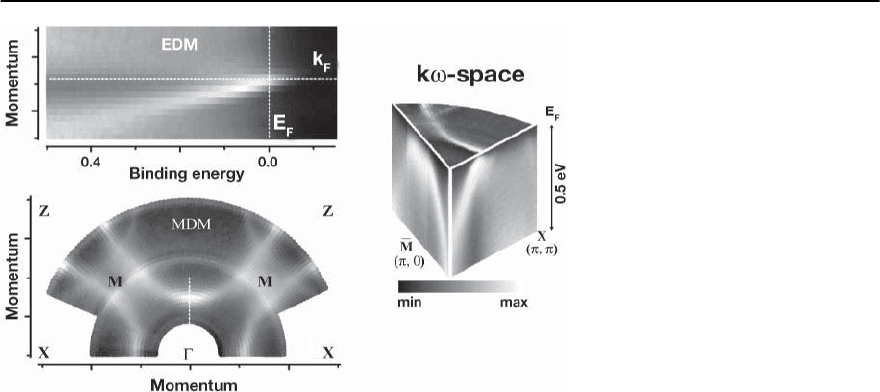
17 Photoemission in the High-T
c
Superconductors 941
Fig. 17.12. Upper panel: Energy distri-
bution map from the −( , ) direc-
tion in the Brillouin zone of Pb-doped
BSCCO recorded at room temperature.
Lower panel: momentum distribution
map of Pb-doped BSCCO, recorded
at room temperature (raw data). The
White horizontal dashed line represents
a k
F
-EDC, vertical lines correspond to
an E
F
-MDC. In both cases the gray scale
represents the photoemission intensity
as indicated. The inset shows the three-
dimensional (k
x
, k
y
, !) space, which is
probed in ARPES of quasi-2D systems
(from [50])
intensity of photoelectrons along the Ycut).Allof
the features — main band (MB), superlattice umk-
lapp bands (UB) and the shadow band (SB) — seen
before [36] and discussed above are confirmed. We
also see weaker, second order umklapps from the su-
perlattice (corresponding to ±(0.42, 0.42), twice the
superlattice wavevector),which confirmsthe diffrac-
tion origin of the superlattice bands.
We now turn to panels (c,d) of Fig.17.11 where we
plot the integrated intensity within a ±100 meV win-
dowaboutthechemicalpotential.Wenotethevery
rapid suppression of intensity beyond ∼ 0.8 M [46],
which does not occur in data taken with 22eV inci-
dent photons. This has led some authors [48,51] to
suggest the existence of an electron-like Fermi sur-
face with a crossing at this point.However,Fretwell et
al. [49] and independently Borisenko et al. [50] have
argued that this Fermi crossing along (0, 0) to (, 0)
is actually due to one of the umklapp bands, and the
near optimally doped Fermi surface is indeed hole
like as earlier shown by Ding et al. [36].
This can be seen most clearly in Pb-doped sam-
ples, where the umklapp bands are not visible. In
Fig. 17.12, we show the Fermi energy intensity map
of Borisenko et al. [50], where the hole surface cen-
teredaround(, ) and its shadow band partner are
quite apparent.
One of the main reasons for the controversy sur-
rounding the topology of the optimal doped Fermi
surface is the fact that data taken at different in-
cident photon energies h lead to different inten-
sity patterns. Our assertion, based on [8,49], is that
the superlattice umklapp band is more noticeable
at h = 33 eV compared with 22 eV since matrix
element effects suppress the main band intensity at
33 eV.Fora detaileddiscussion abouthowto discrim-
inate between a main band and superlattice Fermi
crossing, we refer the reader to the cited papers, and
also to [8, 36] for the use of polarization selection
rules for this purpose.
Matrix Element Effects
There is an important general lesson to be learned
from the above discussion which is equally rele-
vant for the n(k) methods to be discussed below.
Changes in the ARPES intensities (either integrated
over a small energy window or over a large energy
range) as a function of k can be strongly affected
by matrix element effects. This is, of course, obvi-
ous from the expression for the ARPES intensity:
I(k, !)=I
0
(k; ;
ˆ
A)f (!)A(k, !). The key question
is: after integration over the appropriate range in !,
how do we differentiate between the k dependence
coming from the matrix elements I
0
(which we are
not interested in per se) from the k dependence com-
ing from the spectral function?
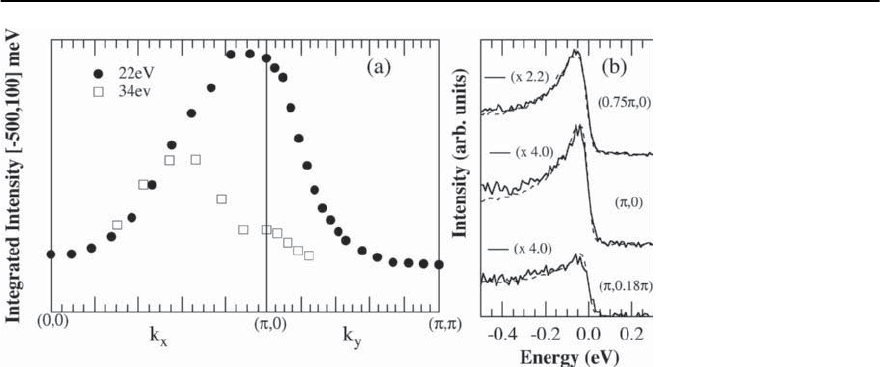
942 J.C. Campuzano, M.R. Norman, and M. Randeria
Fig. 17.13. Bi2201–OD23K.
(a) Integrated intensity
(over the range is −500
to 100 meV) along the
(0, 0) → (, 0) → (, )
directions for two incident
photon energies h =22eV
and 34 eV. (b)Comparison
of the ARPES lineshape
measured at 22 eV (dashed
lines)and34eV(solid
lines) at three different k
points. One curve has been
scaled by the multiplicative
constant indicated to make
itlieontopoftheother
One possibility is to have a priori information
about the matrix elements from electronic structure
calculations [16].But as we now show,even in the ab-
sence of such information, one can experimentally
separate the effects of a strong k-variation of the
matrix element from a true Fermi surface crossing.
The basic idea is to exploit the fact that changing the
incident photon energy one only changes the ARPES
matrix elements and not the spectral function (or
the resulting momentum distribution) of the initial
states.
We will use Bi2201 to illustrate our point since
it has all the complications (points (1),(2) and (4))
listed above without the superlattice (point (3)).Fig-
ure 17.13(a),from[8],shows the intensity (integrated
over a large energy range) as a function of k for OD
23 K Bi2201, and highlights the differences between
data obtained at 221 eV and 34 eV incident pho-
ton energies.At 22 eV the maximum intensity occurs
close to (, 0) and decreases both toward (0, 0) and
(, ), while at 34 eV there is a strong depression of
intensity on approaching (, 0), resulting in a shift
of the intensity maximum away from (, 0).
From the discussion of Sect. 17.2.4, we can write
the integrated intensity as: I(k)=
+∞
−∞
d!I(k, !)=
I
0
(k; ; A)n(k).Weattributethislossinintensity
around (, 0) at 34 eV seen in Fig. 17.13(a) to strong
k-dependence of I
0
rather than n(k). Experimentally
we prove this by showing that the EDCs at the same
point in the Brillouin zone obtained at the two differ-
ent photon energies show exactly the same lineshape,
i.e. one can be rescaled onto the other as shown in
Fig. 17.13(b). As an independent check of this, we
have also shown that the symmetrization analysis
leads to the same conclusion that there is no Fermi
crossing along (0, 0) → (, 0); see Fig. 9 of [8].
For completeness, we note that another possible
source of incident h -dependence in ARPES is k
z
-
dispersion. If there was c-axis dispersion, different
photon energies would probe initial states with dif-
ferent k
z
values consistent with energy conservation.
However the scaling shown in Fig. 17.13(b) proves
that it is the same two-dimensional (k
z
-independent)
initial state which is being probed in the data shown
here, and the h -dependence arises entirely from the
different final states that the matrix element cou-
ples to.
Methods Based on the Momentum Distribution
Finally we turn to the use of the momentum distri-
bution sum rule [20] (discussed in Sect. 17.2.4) in
determining the Fermi surface.In principle, locating
the rapid variation of n(k) offers a very direct probe
of the Fermi surface which we emphasize is not re-
strictedtoFermi liquids.(TheT = 0 momentum dis-
tribution for known non-Fermi liquid systems, such
as Luttinger liquids in one dimension, do show a in-
flection point singularity at k
F
.) However in practice,
one needs to be very careful about the k-dependence
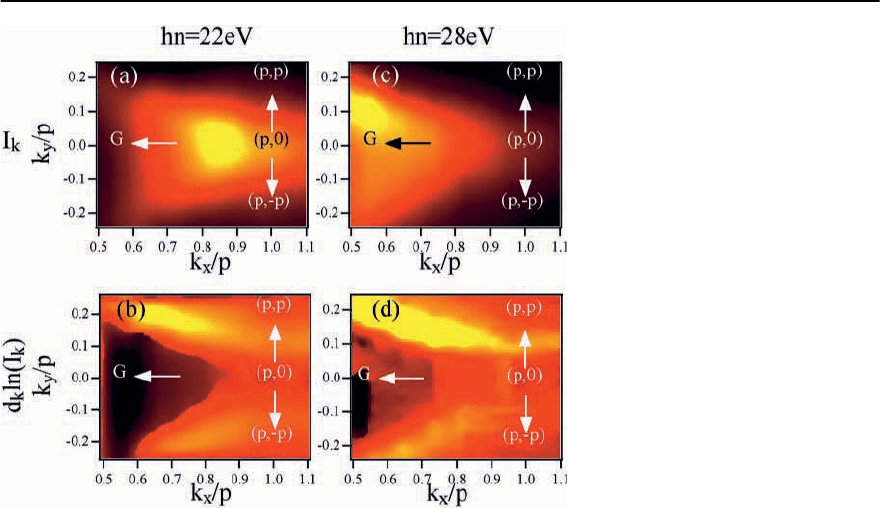
17 Photoemission in the High-T
c
Superconductors 943
Fig. 17.14. Bi2201–OD0K. (a and c)In-
tegrated intensity (over −350 meV to
+50 meV) I(k)measuredat =22eV
and 28 eV around the ( , 0) point. No-
tice that the intensity maximum de-
pends strongly upon the photon en-
ergy .(b and d) Corresponding gra-
dient of the logarithm, |∇
k
I(k)|/I(k),
the maxima which correspond to Fermi
crossings and clearly show that, inde-
pendent of the photon energy,theFermi
surface consists of a hole barrel cen-
tered around (, )
of the matrix elements, as clearly recognized in the
original proposal [20].
Here we discuss two approaches using the n(k)
method to obtain information about the Fermi sur-
face. The first method is to study the k-space gra-
dient of the logarithm of the integrated intensity.
The second method is to study the temperature-
dependence of the integrated intensity and use the
approximate sum rule [20] ∂n(k
F
)/∂T = 0 discussed
in Sect. 17.2.4.
The gradient method was used in our early work
[36,52] where k
F
was estimated from the location of
max |∇
k
n(k)|. The same method has also been suc-
cessfully used later by other authors [53,54]. In the
presence of strong matrix element effects, it is even
more useful to plot the magnitude of the logarithmic
gradient: |∇
k
I(k)|/I(k) which emphasizes the rapid
changes in the integrated intensity. The logarithmic
gradient filters out the less abrupt changes in the
matrix elements and helps to focus on the intrinsic
variations in n (k).
AsanexampleweshowinFig.17.14theresults[8]
of such an analysis for an OD 0K Bi2201 sample. In
the top panels (a) and (c) we show the integrated
intensity I(k)aroundthe(, 0) point obtained at
two different photon energies: 22 eV and 28 eV re-
spectively. In the lower panels 11(b) and (d), we plot
|∇
k
I(k)|/I(k). Note that there are large differences
between the two top panels, due to different matrix
elements at 22 eV and 28 eV. However, as explained
above, the logarithmic gradients in the bottom pan-
els, which are more influenced by the intrinsic n(k),
are much more similar. The Fermi surface can be
clearly seen as two high intensity arcs curving away
from the (, 0) point. Once matrix element effects
are taken care of, the Fermi surface results obtained
at the two different photon energies are quite simi-
lar, and in good agreement with the results obtained
from independent methods like symmetrization on
the same data set [8].
Our final method for the determination of a Fermi
crossing goes back to the sum rule [20] that we had
introduced earlier, ∂n(k
F
)/∂T = 0. Assuming that
the matrix elements are T-independent on the tem-
perature scales of interest, this immediately implies
the integrated intensity at (and only at) k
F
is T-
independent. In Sect. 17.2.4, we had used this sum
rule to get confidence in the validity of the single-
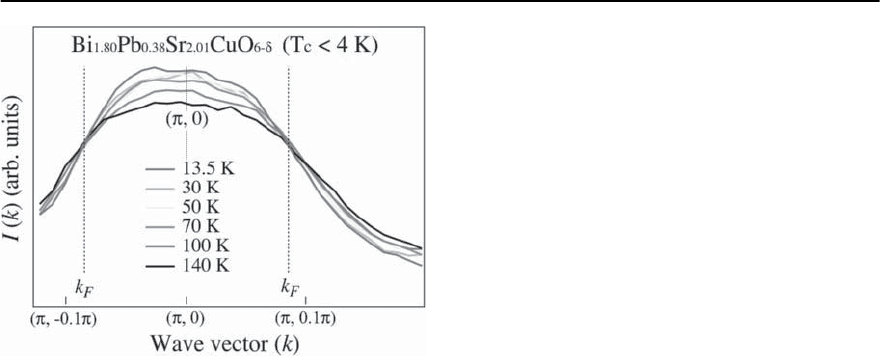
944 J.C. Campuzano, M.R. Norman, and M. Randeria
Fig. 17.15. Temperature dependence of the integrated
ARPES intensity I(k)alongthe(,0)−(, )cut,obtained
by integrating the ARPES intensity from −100 meV to
100 meV. (An angle-integrated temperature-independent
background is subtracted before integration)
particle spectral function interpretation of ARPES
by verifying at k
F
assuming that k
F
was known (by
someothermeans).Nowwecaninvertthelogic:we
can lookat the T dependence of the integrated inten-
sity, and identify k
F
as that point in k-space where
the integrated intensity is T-independent. This is il-
lustratedin Fig.17.15fromthe workof Sato etal.[45],
who determine k
F
along the (, 0) − (, )cutfor
a highly OD Bi2201 sample. The result is completely
consistent with that obtained by other methods,such
as“division by the Fermi function”on the same sam-
ple (see Fig. 17.9).
EDCs vs MDCs
To conclude this discussion, let us note a very recent
development for determining k
F
and the near-E
f
dis-
persion based on the MDCs, which are plots of the
ARPES intensity as a function of k (in this case nor-
mal to the expected Fermi surface), at various fixed
values of !. As shown in Sect. 17.2.5, the MDC peak
position in the vicinity of the Fermi surface, i.e, near
(k = k
F
, ! =0)isgivenby:k = k
F
+[! −£
(!)]/v
0
F
.
Thus k
F
is determined by the peak location of the
MDC at ! = 0. The fully renormalized Fermi ve-
locity v
F
= v
0
F
/[1 − ∂£
/∂!]isgivenbytheslope
of the MDC peak dispersion. We note that the factor
arising from the k-dependence of the self-energy is
already included in v
0
f
,sothatv
0
f
= v
bare
f
[1+∂£
/∂"
k
].
(To see this, note that the analysis of Sect. 17.2.5 can
be easily generalized to retain the first order term
∂£
/∂"
k
without spoiling the Lorentzian lineshape of
the MDC provided this k-dependence does not enter
£
).
As discussed earlier,the above results derive from
the Lorentzian lineshape of the MDC which arises
when three conditions are satisfied: the matrix ele-
ments do not depend on k, the self energy does not
depend on k (except for the (k − k
F
)variationof£
noted above) and dispersion can be linearized near
the Fermi surface. The validity of these assumptions
can be checked self-consistently by the Lorentzian
MDC lineshape and the dispersion deduced from the
data.
The significance of this approach is that, as em-
phasized by Kaminski et al. [24], the dispersions
of the EDC and MDC peak positions are actu-
ally different in the cuprates; see Fig. 17.54(a) in
Sect. 17.7.7. This difference arises due to the non-
Fermi liquid nature of the normal state, so that the
EDC peak dispersion is not given by the condition
! − v
0
F
(k − k
F
)−£
= 0 but also involves in general
£
.In contrast the MDC peak dispersion is rigorously
described by the expression described above, and is
much simpler to interpret.
We expect that the MDC method for determining
the dispersion and k
F
which has thus far been used
mainly along the zone diagonal, will eventually be
the method of choice, except when one is very close
to the bottom of the band where linearization fails.
17.4.3 Summary of Results on the Optimally Doped
Fermi Surface
We have discussed a large number of methods for
determination of the Fermi surface in Bi2201 and
Bi2212 in the previous subsection. These include:
(a) dispersion of EDC peaks through E
f
,(b)disper-
sion of peaks after division by the Fermi function,
(c) symmetrization, (d) maps of intensities at E
f
,(e)
gradient of n(k), (f) T-dependence of n(k), and (g)
MDC dispersion. In addition we also discussed using
the h -dependence of the data and polarization se-

17 Photoemission in the High-T
c
Superconductors 945
lection rules to eliminate matrix element effects and
to identify superlattice Fermi crossings.
The reader might well ask: why so many different
methods? The reason is that the development of all of
these methods has taken place to deal with the com-
plicationsof accurately identifyingthe Fermi surface
in the presence of the four problems listed at the be-
ginning of the preceding subsection. Each method
has its pros and cons, so that some, like (b) and (c)
require very accurate E
f
determination, which is not
the case in (e) and (f) which use energy-integrated
intensities. Most methods require dense sampling in
k space, while method (f) requires in addition data
at several temperatures.
Given the complications of the problem at hand it
is important to look for crosschecks and consistency
between various ways of determining the Fermi sur-
face.We believe that for optimally doped Bi2201 and
2212 there is unambiguousevidence for a single hole
barrel centered about the (, ) point enclosing a
Luttinger volume of (1 + x) holes where x is the hole
doping. We discuss further below the issues of the
doping-dependence of the Fermi surface and of bi-
layer splitting in Bi2212.
17.4.4 Extended Saddle Point Singularity
The very flat dispersion near the (, 0) point ob-
served in all of the data is striking. Specifically, along
(0, 0) to (, 0) there is an intense spectral peak corre-
sponding to the main band, which disperses toward
E
F
but stays just below it. This is often called the
“flat band” or “extended saddle point”, and appears
to exist in all cuprates, though at different binding
energies in different materials [7,43,55].
In our opinion this flat band is not a consequence
of the bare electronic structure, but rather a many-
body effect, because a tight-binding description of
such a dispersion requires fine-tuning (of the ra-
tio of the next-near-neighbor hopping to the near-
neighbor hopping) which would be unnatural even
in one material, let alone many.
An important related issue is whether this flat
band leads to a singular density of states. It is very
important to recognize that, while Fig. 17.8(b) looks
lik e a conventional band structure, the dispersing
states whose “peak positions” are plotted are ex-
tremely broad, with a width comparable to binding
energy, and these simply cannot be thought of as
quasiparticles. This general point is true at all k’s,
but specifically for the flat band region it has the ef-
fect of spreading out the spectral weight over such a
broad energy range that any singularity in the DOS
would be washed out.This is entirely consistent with
the fact that other probes (tunneling, optics, etc.) do
not find any evidence for a singular density of states
either.
17.4.5 Bilayer Splitting?
On very general grounds, one expects that the two
CuO
2
layers in a unit cell of Bi2212 should hybridize
to produce two electronic states which are even and
odd under reflection in a mirror plane mid-way be-
tween the layers. Where are these two states? Why
then did we find only one main “band” and only one
Fermi surface in Bi2212?
Let us first recall the predictions of electronic
structure calculations [56]. In systems like Bi2212,
the intra-bilayer hopping as a function of the in-
plane momentum k is of the form [28,57] t
⊥
(k)=
−t
z
(cos k
x
−cosk
y
)
2
. Thus the two bilayer states
are necessarily degenerate along the zone diagonal.
However they should have a maximum splitting at
¯
M =(, 0) of order 0.25 eV,which may be somewhat
reduced by many-body interactions.
Depending on the exact doping levels and on the
presence of Bi–O Fermi surface pockets, which are
neither treated accurately in the theory nor observed
in the ARPES data, we must obtain one of the two
following situations: (1) the bilayer antibonding (A)
state is unoccupied while the bonding (B) state is oc-
cupied at(, 0).This would lead toan A Fermi cross-
ing along (0, 0)−(, 0) and a B Fermi crossing along
(, 0)−(, ).As described at great length abovewe
did not find evidence for a main band Fermi cross-
ing along (0, 0) − (, 0) at least for the near optimal
doped sample, therefore this possibility is ruled out.
(2) The second possibility is that both the A and B
bilayer states are occupied at the (, 0). In this case,
there should be two (in principle, distinct) Fermi
crossings along (, 0) − (, ), although they might
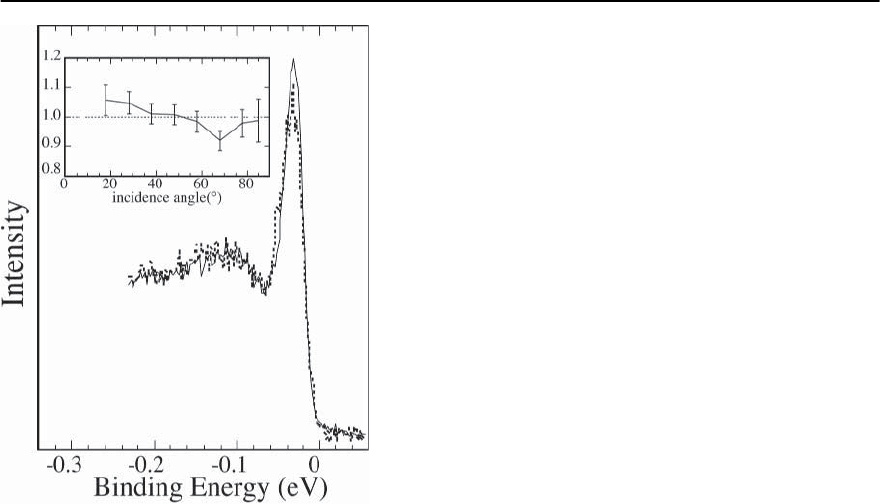
946 J.C. Campuzano, M.R. Norman, and M. Randeria
Fig. 17.16. Low temperature (T =13K)EDC’sofnearopti-
mal T
c
= 87 K Bi2212 at (, 0) for various incident photon
angles. The solid (dashed) line is 18
◦
(85
◦
) from the nor-
mal. The inset shows the height of the sharp peak for data
normalized to the broad bump,at different incident angles
be difficult to resolve in practice. Nevertheless, one
would definitely expect to see two distinct occupied
states at the (, 0) point. Unfortunately, the normal
state spectrum at (, 0) is so broad in the optimally
doped and underdoped materials that it is hard to
make a clear case for bilayer splitting. Thus an effort
was made to search for this effect in the supercon-
ducting state at T T
c
,when a sharp feature (quasi-
particle peak) is seen (see Fig. 17.16) and one might
hope that the bilayer splitting should be readily ob-
servable.
The issue then is how to interpret the
peak/dip/hump structure seen in the ARPES line-
shape at (, 0) in Fig. 17.16. The peak/dip/hump
structure will be discussed at length in Sect. 17.7 be-
low. Nevertheless, here we will briefly address the
question of whether: (I) the peak and the hump are
the two bilayer split states, which are resolved below
T
c
once the peak becomes sharp? Or (II) is the non-
trivial lineshape due to many-bodyeffectsin a single
spectral function A(k, !)?
Three pieces of evidence will be offered in favor
of hypothesis (II) as opposed to (I), so that no bilayer
splitting is observable even in the superconducting
stateof nearoptimaldopedBi2212.Thefirstevidence
comes from studying the polarization dependence
of the ARPES matrix elements. For case (I) there are
two independent matrix elements which, in general,
should vary differently with photon polarization A,
and thus the intensities of the two features should
vary independently as A is varied.On the other hand,
for case (II), the intensities of the two features are
governed by a single matrix element. As shown in
Fig. 17.16 it was found in [36] that by varying the z-
component of , the peak and hump intensities scale
together, and thus the peak/dip/hump are all part of
a single spectral function for Bi2212.
A second piece of evidence comes from a compar-
ison [58] of the normal and superconducting state
dispersions near the (, 0) point, which will be dis-
cussedindetailinconnectionwithFigs.17.43and
17.44 of Sect. 17.7.4. From these data, we argue that
there is no evidence for a feature above T
c
,which
would correspond to the dispersionless quasiparti-
cle peak below T
c
.Thus the dispersionless peak must
be of many-body origin.
The third and final piece of evidence comes from
both ARPES and SIS tunneling. In the ARPES data
[59] shown in Fig. 17.50 of Sect. 17.7.6 one sees the
striking fact that while the energy scales of both the
quasiparticle peak andthe (, 0) hump increasewith
underdoping, their ratio is essentially doping inde-
pendent. Since the location of the peak is the (maxi-
mum) superconducting gap — as discussed in detail
in Sect. 17.5 — the (, 0) hump energy scales with
the gap. SIS tunneling data also finds the same cor-
relation on a very wide range of materials (including
some which have a single CuO plane) whose gap en-
ergies vary by a factor of 30 [60]. This provides very
strong evidence that both the peak and hump are re-
lated to many-body effects and not manifestations of
bilayer splitting.We note thatAnderson [61] had pre-
dicted that many-body effects within a single layer
could destroy both the quasiparticles and the coher-
ent bilayer splitting in the normal state.Butwhythe
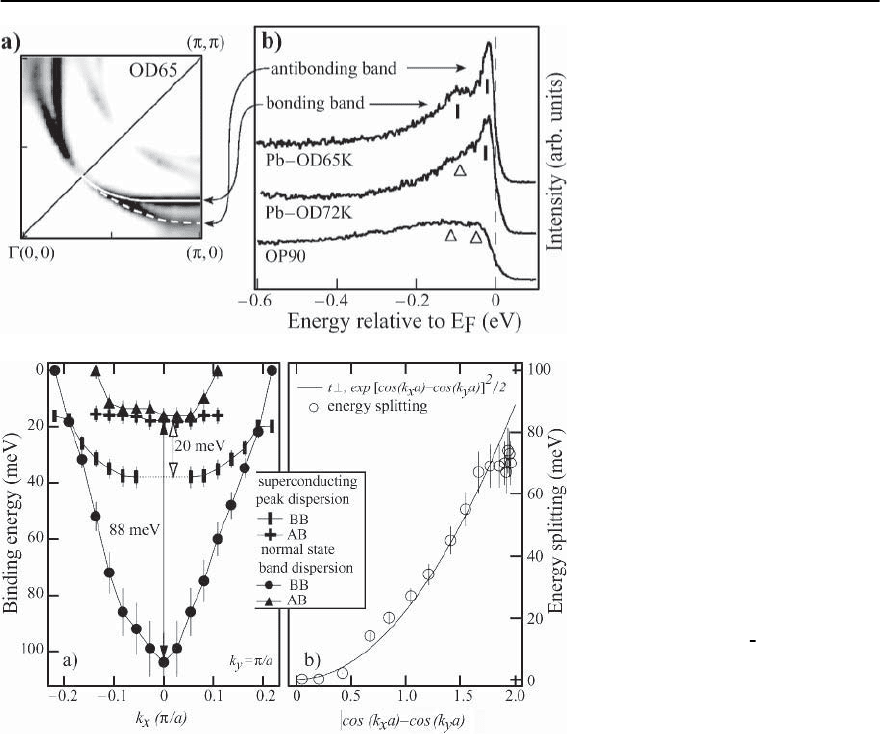
17 Photoemission in the High-T
c
Superconductors 947
Fig. 17.17. (a) Bilayer-split Fermi sur-
faces of heavily overdoped OD65; the
two weaker features are their su-
perstructure counter parts. Solid and
dashed lines represent the bonding
and antibonding Fermi surfaces, re-
spectively. (b) Normal state photoemis-
sion spectra of Bi2212 taken at (, 0)
for three different doping levels. Data
were taken with h =22.7 eV pho-
ton.Bars indicate identified feature po-
sitions, and triangles indicate possible
feature positions (from [62])
Fig. 17.18. (a) Dispersion extracted
from heavily overdoped OD65. (b)En-
ergy splitting along the antibonding
Fermi surface, which is obtained from
data shown in Fig. 17.17. It is sim-
ply the binding energy of the bonding
band, since the binding energy of the
antibonding band is zero at its Fermi
surface. The curve is
1
2
t
⊥,exp
[cos(k
x
a)−
cos(k
y
a)]
2
,wheret
⊥,exp
=44±5meV.
Error bars are due to the uncertain-
ties in determining the energy position
(from [62])
splitting should not be visible in the superconduct-
ing state, where sharp quasiparticles do exist, is not
clear from a theoretical point of view.
Recently,the above picture has been challenged by
a number of authors [62–64].What has become clear
is that bilayer splitting is indeed present for heavily
overdoped Bi2212 samples,and hasbeen seen now by
several groups, including our own. In Fig. 17.17, we
show (a) the bilayer split Fermi surfaces and (b) the
bilayer split EDCs observed by the Stanford group for
a heavily overdoped (T
c
= 65 K) Bi2212 sample.Note
that the bilayer splitting can even be seen in the umk-
lapp bands. The resulting dispersion is reproduced
in Fig. 17.18, where one sees that the momentum de-
pendence of the splitting follows that expected from
electronic structure considerations [28,57].
How this effect evolves as a function of doping,
though, is still controversial. In particular, if it is
present for optimal doping, it is difficult to resolve.
Moreover, some authors who advocate bilayer split-
ting still argue that the peak/dip/hump structure in
the superconducting state is largely a many-body ef-
fect [62] as we advocate here. This is supported by
the fact that the same lineshape is seen in trilayer
Bi2223 [65], where one would expect three features if
layer splitting were causing these effects. And simi-
lar lineshapes have been seen by tunneling in single
layer systems, in support of a many-body interpre-
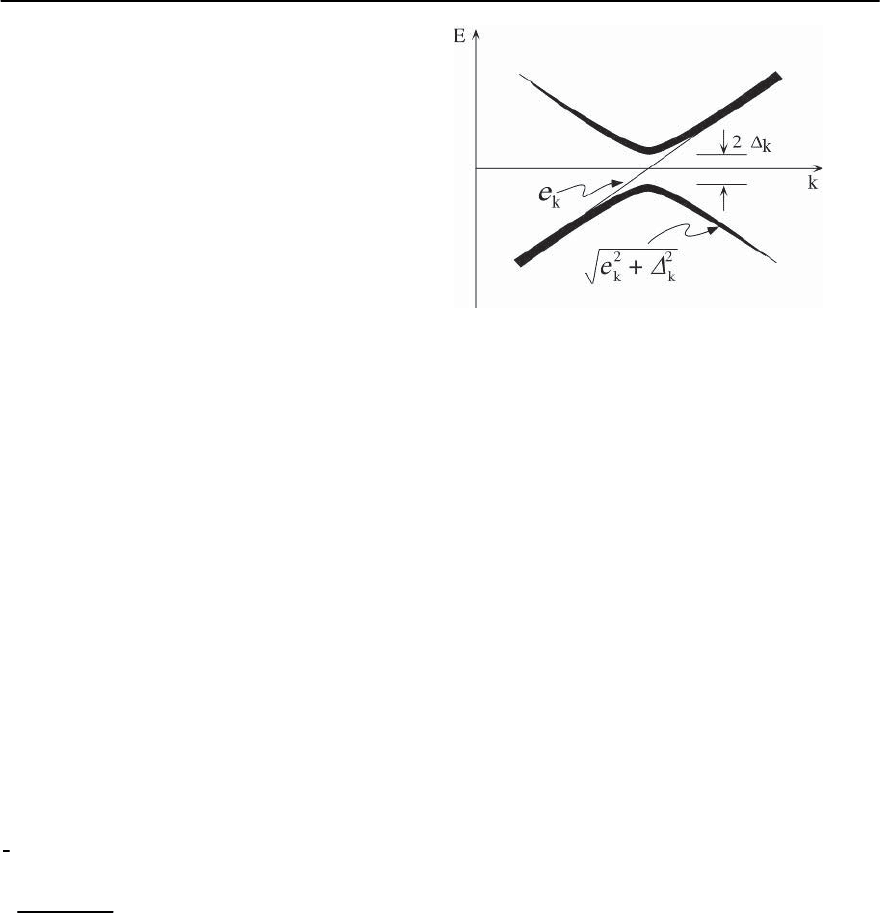
948 J.C. Campuzano, M.R. Norman, and M. Randeria
tation. The reader is referred to [2], where the issue
of bilayer splitting is discussed in greater detail than
here.
17.5 Superconducting Energy Gap
In this Section, we will first establish how the su-
perconducting (SC) gap manifests itself in ARPES
spectra, and then directly map out its variation with
k along the Fermi surface. This is the only avail-
able technique formeasuring the momentum depen-
dence of the energy gap, and complements phase-
sensitive tests of the order parameter symmetry [66].
Thus ARPES has played an important role [67], [68]
in establishing the d-wave order parameter in the
high T
c
superconductors [66]. At the end of the sec-
tion,we will discuss the doping dependence of the SC
gap and its anisotropy, and the implications of this
study for various low temperature experiments like
thermal conductivity and penetration depth.
17.5.1 Particle–Hole Mixing
To set the stage for the experimental results it may be
useful to recall particle–hole (p–h) mixing in the BCS
framework (even though, as we shall see in Sect. 17.7,
there are aspects of the data which are dominated by
many body effects beyond weak coupling BCS the-
ory). The BCS spectral function is given by
A(k, !)=u
2
k
/((! − E
k
)
2
+
2
)
+ v
2
k
/((! + E
k
)
2
+
2
) , (17.11)
where the coherence factors are v
2
k
=1−u
2
k
=
1
2
(1 −
k
/E
k
)and is a phenomenological linewidth.
The normal state energy
k
is measured from E
f
and the Bogoliubov quasiparticle energy is E
k
=
2
k
+ |(k)|
2
,where(k)isthegapfunction.Note
that only the second term in Eq. (17.11), with the v
k
-
coefficient, would be expected to make a significant
contribution to the EDCs at low temperatures.
In the normal state above T
c
, the peak of A(k, !)
is at ! =
k
as can be seen by setting =0in
Eq. (17.11). We would thus expect to see in ARPES
a spectral peak which disperses through zero bind-
ing energy as k goes through k
F
(the Fermi surface).
Fig. 17.19. Schematic dispersion in the normal (thin line )
and superconducting (thick lines) states following BCS the-
ory. The thickness of the superconducting state lines indi-
cate the spectral weight given by the BCS coherence factors
u and v
In the superconducting state, the spectrum changes
from
k
to E
k
; see Fig. 17.19. As k approaches the
Fermi surface the spectral peak shifts towards lower
binding energy,but no longer crosses E
f
. Precisely at
k
F
the peak is at ! = |(k
F
)|, which is the closest
it gets to E
f
. This is the manifestation of the gap in
ARPES. Further, as k goes beyond k
F
,intheregionof
states which were unoccupied above T
c
,thespectral
peak disperses back,receding away from E
f
,although
with a decreasing intensity (see Eq. (17.11)). This is
the signature of p–h mixing.
Experimental evidence for particle–hole mixing
in the SC state was first given in Ref. [52].In Fig.17.20
we show normal and SC state spectra for Bi2212 for
k’s along the cut shown in the inset. In the normal
statedatainpanel(b)weseetheelectronicstatedis-
persing through E
f
:thek’s go from occupied (top
of panel) to unoccupied states (bottom of panel).
The normal state dispersion is plotted as black dots
in Fig. 17.21 (b). The k
F
obtained from this disper-
sion is in agreement with that estimated from the
|∇
k
n(k)| analysis of the normal state data shown in
Fig. 17.21(a).
We see from Fig.17.20 (a) that the SC state spectral
peaks do not disperse through the chemical poten-
tial, rather they first approach ! = 0 and then recede
away from it.The differencebetween the normal and
SC state dispersions is clearly shown in Fig.17.21 (b).
